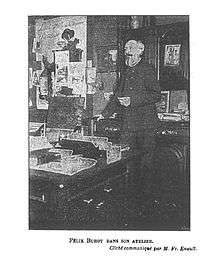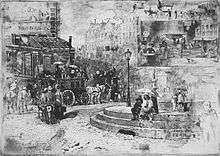Félix Buhot
Félix Hilaire Buhot (July 9, 1847 - April 26, 1898) was a French painter and illustrator.


Among the most original prints made in France during the last quarter of the nineteenth century are those by Félix Buhot. Along with artists like Charles Jacque, Louis Monziès and Félix Bracquemond, he is credited with reviving seventeenth-century etching techniques in late nineteenth-century art. However, he was highly experimental and regularly employed technical variables and regularly combined multiple processes to produce a single print. He used traditional techniques of etching, drypoint, and aquatint along with modern methods such as photomechanical reproduction. Buhot’s most notable contribution to the history of printmaking is a device he termed "marges symphoniques" (symphonic margins). Inspired by the marginal decorations of medieval manuscripts and eighteenth-century French book illustrations, Buhot developed two types of margins, etching the first on the same plate as the central subject and printing the second, called a “false margin,” from a separate plate.[1]
In his many prints of city views and seascapes, Buhot was intent on creating a specific atmosphere, especially the effects of weather such as rain, snow, mist, and fog. He turned to his immediate neighborhood in and around the boulevard de Clichy in Montmartre, Paris, for inspiration for his prints of everyday city life. Buhot delighted in portraying the varied street life of the vibrant capital city not only in different seasons (Winter in Paris, 1879) but also in moments of public display, from a festive holiday celebration (National Holiday on the Boulevard de Clichy, 1878) to a somber death observance (Funeral Procession on the Boulevard de Clichy, 1887). His city views also include London scenes (Westminster Palace and Westminster Bridge, both of 1884). And Buhot's love for the sea is evidenced in the many prints exploring its ever-changing atmospheric conditions and moods. Buhot's boat trips to England inspired two of his most characteristic prints, A Pier in England and Landing in England, both from 1879.
With his experimental printmaking techniques, Buhot became one of the best-known, admired, and collected printmakers of his day. He achieved success for his prints at the annual Salons between 1875 and 1886, and a number of his works were published in leading periodicals and books. He also found critical acclaim and support for his prints in the United States, especially after his first one-man exhibition organized by the New York print dealer Frederick Keppel in 1888.
On February 15, 1888 he made an exhibition in New York City.
He died in 1898.
References
- Abbé J.L. Adam, Quelques notes sur Valognes, Cherbourg : Impr. Émile Le Maout, 1905. p 633
Bibliography
- J.-L. ADAM, Notice sur la vie et l'œuvre de Félix Buhot, Évreux, impr. de l'Eure, 1900
- Bourcard, Catalogue descriptif de l'œuvre gravé de Buhot, Paris, Floury, 1899
- J.-L. Dufresne, V. Sueur, A. Mc Queen, Félix Buhot. Peintre graveur entre Romantisme et impressionnisme. 1847-1898, Cherbourg, Isoète, 1998
- Pierre Leberruyer, Le Peintre graveur aquafortiste Félix Buhot (1847–1898), [?]: Editions Manche-Tourisme. 1979, 119 p.
- Léonce Bénédite, Félix Buhot : Étude biographique et critique, suivie du catalogue de l'œuvre gravé de cet artiste exposé au Musée du Luxembourg, Paris, Librairie de l'Art ancien et moderne, (1902). 24 p., fig. et pl. Extrait de la Revue de l'art ancien et moderne.
- [The] late Félix Buhot, painter-etcher, New York, F. Keppel, [1910?]. 37 p., ill.
- Roger-Marx Claude (1962) La Gravure originale au XIV siecle, Paris, Somogy. pp. 152–154.
External links
- Biography by Bernard Derroitte
- Armstrong Fine Art: overview of works by Félix Buhot
- The Prints of Félix Buhot:Impression of City and Sea
- Félix Buhot at Joconde
- Félix Buhot in the artcyclopedia
- Pierre Bonnard, the Graphic Art, an exhibition catalog from The Metropolitan Museum of Art (fully available online as PDF), which contains material on Buhot (see index)
| Wikimedia Commons has media related to Félix Buhot. |